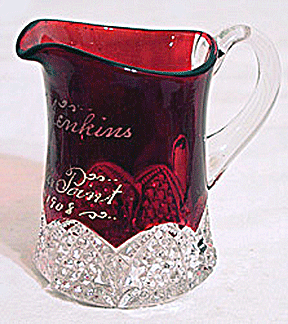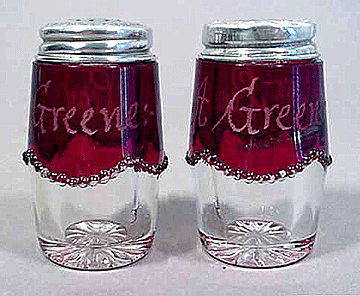 Ruby glass is the dark red color of the precious
gemstone ruby. This popular Victorian color never went out of style and it’s
still cherished today as it was then.. According to Naomi L. Over, author of
Ruby Glass of the Twentieth Century Volumes 1 and 2 and a collector
of over 5,000 pieces of the gem-colored glass, ruby glass is the second most
popular collectible. Ruby glass is the dark red color of the precious
gemstone ruby. This popular Victorian color never went out of style and it’s
still cherished today as it was then.. According to Naomi L. Over, author of
Ruby Glass of the Twentieth Century Volumes 1 and 2 and a collector
of over 5,000 pieces of the gem-colored glass, ruby glass is the second most
popular collectible.
"I like it for the color," she said. And so, it
seems do many other people.
There’s a myth about the discovery of a formula for red
glass: Someone dropped a gold ring into a vat of molten glass and it turned
red. This is unlikely to be true as experiments have shown that all that appears is a puddle of molten
gold at the bottom of the unchanged pot of molten glass. The gold has to be chemically treated
before adding it to the glass mixture.
The first written instructions for making gold ruby glass
date back to 1685 when Andreas Cassius published his work, De Auro, in
which he described for the first time the method of producing a red
precipitate of stannic acid with gold, which later became known as the
"Purple of Cassius." The high price which this glass commanded and
the efforts needed to produce it could hardly be justified by its beauty,
but the mysticism connected with gold caused the demand.
However, the Romans made gold ruby glass long before
Cassius. The famous Lycurgus Cup, made in the 4th Century AD., contains both
gold and silver. An exceptional example of the glass-making skills of the
Romans, it now rests in the British Museum in London.
The secret of making red glass, lost for many centuries,
wasn’t rediscovered until the 17th Century in Brandenburg, Bohemia. Johann
Kunckel, a chemist from a glass-making family, re-discovered how to make
gold ruby glass around 1670 and published the results of his experiments in
his famous book Ars Vetraria Experimentalis in 1679.
 The preparation of red ruby glass is still based on
Cassius's instructions: " To
make gold ruby glass, include gold chloride, a colloidal gold solution
produced by dissolving gold metal in Aqua Regia (nitric acid and
hydrochloric acid) in the glass mixture. Tin (stannic chloride) is sometimes
added in tiny amounts, making the process both difficult and expensive. The
tin has to be present in the two chloride forms because the stannous
chloride acts as a reducing agent to bring about the formation of the
metallic gold. Depending on the composition of the base glass, the ruby
color can develop during cooling, or the glass may have to be reheated to
‘strike’ the color." The preparation of red ruby glass is still based on
Cassius's instructions: " To
make gold ruby glass, include gold chloride, a colloidal gold solution
produced by dissolving gold metal in Aqua Regia (nitric acid and
hydrochloric acid) in the glass mixture. Tin (stannic chloride) is sometimes
added in tiny amounts, making the process both difficult and expensive. The
tin has to be present in the two chloride forms because the stannous
chloride acts as a reducing agent to bring about the formation of the
metallic gold. Depending on the composition of the base glass, the ruby
color can develop during cooling, or the glass may have to be reheated to
‘strike’ the color."
Today's studio glassmakers can buy their gold ruby glass
in rods from specialist manufacturers. This makes it easier for them, but
even more expensive. Most gold ruby glass items made today have a thin layer
of gold ruby glass coated with clear crystal. There are other chemicals which produce red glass, but
none which have the special magic
of gold ruby. Most red and pink glass today and for many
years past is made from selenium. Frederick Carder, working at the Steuben
Glass Works, invented a brilliant red glass by incorporating cadmium
selenide and zinc sulphide in the mixture. Cadmium sulphide glass, which is
yellow, changes to orange when selenium is added and to bright ruby red when
sufficient selenium is added.
 The number of companies making ruby glass have diminished
in recent years. "The environmental agencies have come hard on the
manufacturers of ruby glass," said Over. "It cost the Mosser Glass
Company, which makes small items like animals, $1.5 million to put in a new
chimney." The number of companies making ruby glass have diminished
in recent years. "The environmental agencies have come hard on the
manufacturers of ruby glass," said Over. "It cost the Mosser Glass
Company, which makes small items like animals, $1.5 million to put in a new
chimney."
Other than its inherent color and possible shape, ruby
glass pieces aren’t easily identified.
Most Royal Ruby glass wasn’t marked or signed. The glass
usually came from the factory with a sticker identifying the Royal Ruby
color. When items were marked, the mark is an anchor with the letter H over
the middle. "Unfortunately, manufacturers began using stickers in the
1940s, which got washed or pulled off," said Over, who has been
collecting ruby glass for nearly 35 years. "The Fenton Glass Company
used a silver label with an ‘F’."
Royal Ruby refers solely to the red glassware made by
Anchor Hocking. Their initial promotion started in 1938. Some people tend to
throw all red glassware into the Royal Ruby category regardless of what
company made it. Strictly speaking, Royal Ruby was the term coined by Anchor
Hocking to describe the red glassware issued during its late 30̓s
early 40̓s Royal Ruby Promotion.
According to Glenda Farris of Boxer Heart Glass of
Houston, Texas, the early Depression glass patterns, like Coronation and Old
Café sell well, as do any of the vases
and Anchor Hocking’s square Charm pattern.
< Back to
Antiques Articles
Go to the next antiques article
> |
